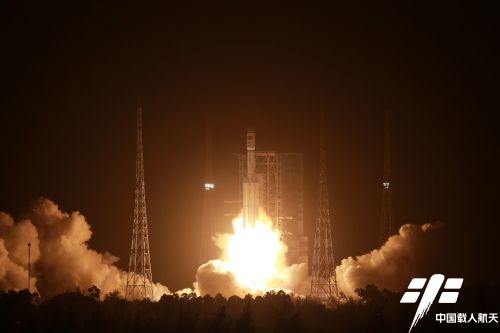China launches a new cargo unit to the space station it is building ... What will happen to the rocket this time?
ArabiaWeather - China launched vehicle shipping space Tianzhu -2 (Tianzhou-2) from the launch pad in China 's Hainan Island on Saturday (May 29th) 8:55 pm local time, which was on board the rocket "Long March 7" ( Long March 7), and it deployed its solar arrays as expected and are in good condition, according to the China Aerospace Engineering Bureau (CMS).
The Tianzhu-2 unmanned vehicle carries about 4.69 tons of compressed materials and 1.95 tons of fuel. If all goes according to plan, the cargo craft will transport these materials to "Tianhe", which is the basic unit of the Chinese space station being built, which has been launched into orbit. My land is low (April 29).

The arrival of the cargo vehicle will help prepare "Tiankha" to receive astronauts, as the Shenzhou-12 mission consisting of three astronauts is scheduled to launch towards "Tianhe" next month.
And Tianhe (which means the harmony of the heavens) is the central piece of the first Chinese space station, consisting of three units, which China intends to fully assemble by the end of 2022. It will take a total of (11) launches to build the station, the first two of which have now been completed.

(Photo of the Chinese Tianzhou-2 cargo vehicle before its launch to reach the base unit of the China Space Station)
China Space Station Project and China's Space Experiences
The space station project has been in operation for nearly 30 years, and China has gained a lot of experience in orbital assembly over the past decade. In September 2011, for example, China launched a prototype space laboratory called Tiangong-1, which hosted three crews of astronauts, and in 2012 and 2013. Two manned missions spent about two weeks aboard the space laboratory.
And in September 2016, China launched Tiangong-2 and sent three astronauts to the lab for three months. And in April 2017, the Tianzhou-1 spacecraft met with Tiangong-2, and conducted a series of docking and refueling exercises over the next five months.
None of the typical space laboratories remained in its orbit, as Tiangong-1 fell to Earth in an uncontrolled manner in April 2018, and burned over the South Pacific Ocean. While the Tiangong-2 expedition was led on its return to Earth and landed in July 2019 over the South Pacific as well.
The base stage of the Long March 5B missile, which launched the "Tiankha" unit, went out of control and entered Earth in an uncontrolled manner and its components were scattered in the Indian Ocean on (May 8) after 10 days during which it remained in orbit and caused concern. The world and their fear of falling into a populated area.
But the missile out of control is out of the question this time because the first stage of the Long March 7 missile does not reach orbit, but rather lands in a pre-defined area in the ocean.
Arabia Weather App
Download the app to receive weather notifications and more..



